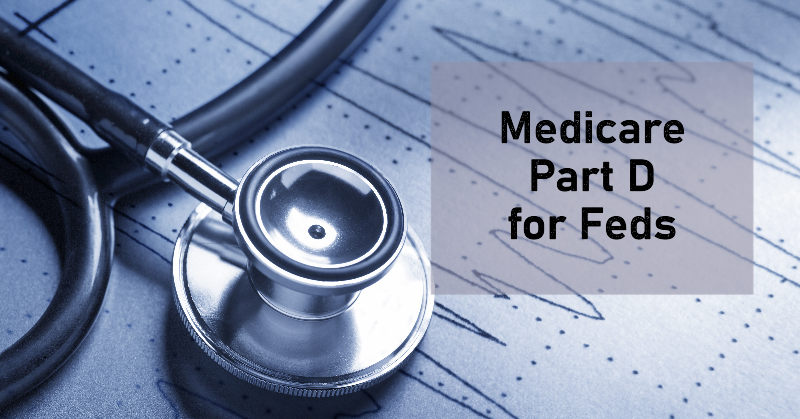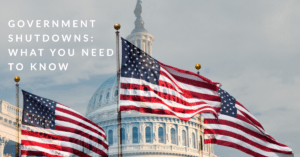What Federal Employees and Retirees need to know when it comes to Medicare Part D and the FEHB (federal employee health benefits) program.
What FEHB Enrollees Should Know About Medicare Part D
Federal employees and retirees typically did not have to consider Medicare part D coverage when dealing with the figuring out the complexities of healthcare coverage. That is not necessarily the case anymore, thanks to the 2022 Inflation Reduction Act.
This article provides an overview of Medicare Part D coverage as well as some pros and cons to help Federal Employees Health Benefits (FEHB) enrollees make the right decision.
Learn about FEHB, TSP, the FERS pension, and more at our 3-hour retirement webinars. Register today.
Advantages of Medicare D for FEHB Participants
Cap on Insulin Expenses
Effective at the start of 2023, those covered by Medicare part D pay no more than $35 per month for insulin. If an FEHB enrollee has diabetes and the cost of insulin is burdensome, a $35 monthly cap can definitely help alleviate the strain caused by healthcare costs.
Medicare Part D Catastrophic Coverage Limit
When the annual cost of prescriptions reaches a certain ceiling, it become categorized as “catastrophic.” For 2024, the annual limit is $8000. Once a covered individuals enter this “catastrophic” phase, they will pay nothing more out-of-pocket. Before the beginning of this year (2024), those also enrolled in an FEHB plan had to pay 5% of expenses over the limit. This 5% “fee” is no longer applicable.
Thinking about retirement from the government? Get a free snapshot of your federal benefits with our benefits report. Schedule a meeting now.
6% Maximum Annual Premium Increase
Starting in 2024, thanks to the aforementioned Inflation Reduction Act, the annual premium is legally prohibited from rising higher than 6% until at least 2030. This is significant because when the yearly premium increase was left unchecked, it at times rose steeply. From 2022 to 2023, for instance, the premiums for Medicare D coverage went up 10%. Between 2023 and 2024, the last year without the 6% maximum, premiums increased by 7.5%.
$2000 Annual Out-of-Pocket Costs for Prescription Drugs
This might the biggest reason more FEHB enrollees will choose to purchase Medicare D coverage for the upcoming year. Effective at the onset of the 2025 calendar year, those covered by Medicare part D will not pay out-of-pocket expenses exceeding $2000. It is technically a monthly cap with out-of-pocket expenses for prescriptions capped at $167 per month.
If you’re enrolled in an FEHB plan and pay more than $167 out-of-pocket for prescription drugs on a monthly basis, then attaining part D coverage might be a smart choice.
Cons of Medicare D for FEHB Enrollees
Premium Costs of Medicare Part D Coverage
Importantly, whether Medicare part D is worth it depends how well one’s current FEHB prescription drug plan is covering their particular healthcare needs. If the above advantages wouldn’t boost your financial and healthcare plans, then the premium costs of the health coverage probably aren’t worth it. If you’re not paying more than $167 monthly or $8000 annually for prescriptions, or $35 monthly for insulin, then adding Medicare part D might be superfluous.
Taking Time to Make an Informed Decision
The best way for federal employees or retirees over the age of 65 to know if Medicare part D coverage is a good fit for their situation is to take the time and map out how much they anticipate to pay to cover their healthcare needs. If the premium for Medicare D ($43 per month is the average premium cost for 2024) is offset by a reduction in out-of-pocket prescription expenses, then enrolling might be a good idea.
Unlike with Medicare Part B coverage, there is no late enrollment penalty. You can choose to add part D at any point without any direct financial repercussions. This means you have the time to make a well informed choice.
Want to discuss your federal benefits with a Chartered Federal Employee Benefits Consultant (ChFEBC℠)? Schedule a free meeting.
Knowledge is Confidence!
More Information About Medicare Part D for FEHB Enrollees
Overview of Medicare Part D Coverage
Medicare Part D is a federal program that provides prescription drug coverage to individuals enrolled in Medicare. This program is designed to help beneficiaries afford their prescription medications. For federal employees and retirees, understanding how Medicare Part D coverage works can significantly impact their overall healthcare costs and choices. The Medicare prescription drug program is structured to provide essential support for individuals over the age 65 who require regular medication, ensuring that enrollees can access necessary treatments without incurring unmanageable out-of-pocket expenses.
Eligibility for FEHB Enrollees
Eligibility for Medicare Part D is generally determined by age and disability status. Most individuals become eligible for Medicare when they turn 65, while others may qualify earlier due to certain disabilities. For FEHB enrollees, it is important to note that being enrolled in Medicare does not affect their eligibility for FEHB coverage. Federal employees and retirees can maintain their FEHB plans while also enrolling in Medicare Part D, allowing them to benefit from both programs. However, it is important to understand the specific eligibility criteria and enrollment processes associated with each program to maximize healthcare benefits.
How to Enroll in Medicare Part D as a Federal Employee
Steps to Enroll in Medicare Part D
Enrolling in Medicare Part D as a federal employee involves the following steps:
- Ensure eligibility (Age 65 or Older or with Disability)
- Choose an Appropriate Medicare Part D Plan
- Initiate Enrollment Process via Medicare website or by contacting the Social Security Administration
- Determine whether a standalone plan is needed or to opt for a Medicare Advantage plan that includes drug coverage
Important Deadlines for Enrollment
The enrollment timeline for Medicare Part D for federal employees and retirees typically begins three months before an individual turns 65 and lasts for seven months. Additionally, there are annual open enrollment periods where individuals can make changes to their Medicare coverage. The open season for Medicare takes place from mid-October to the first week of December.
During the FEHB open season, federal employees have the opportunity to review and adjust their health plans, including prescription drug coverage. This period is particularly important for those considering enrolling in Medicare Part D, as it allows them to assess how their current FEHB plan aligns with their Medicare options. FEHB enrollees should carefully evaluate their health needs, prescription drug requirements, and the benefits offered by their current plan versus potential Medicare Part D plans. This strategic assessment can lead to more informed decisions that optimize healthcare coverage and minimize costs. FEHB open season starts in mid-November and ends around early December as well.
How Does Medicare Part D Work with FEHB Plans?
Coordination of Benefits Between Medicare and FEHB
The coordination of benefits between Medicare and FEHB plans is essential for federal employees to understand. When an individual is enrolled in both Medicare and an FEHB plan, Medicare typically serves as the primary payer for healthcare services, while the FEHB plan acts as the secondary payer. This arrangement can lead to reduced out-of-pocket costs for enrollees, as the FEHB plan may cover some expenses that Medicare does not. It is crucial for federal employees to contact their FEHB plan to clarify how benefits will be coordinated and to ensure they are maximizing their coverage.
Prescription Drug Benefits in FEHB Programs
Many FEHB plans offer substantial prescription drug benefits, which can complement or even exceed the coverage provided by Medicare Part D. Federal employees should review their FEHB plan’s formulary to understand which medications are covered and at what cost. Additionally, some FEHB carriers may have specific arrangements with pharmacies that can further reduce prescription drug costs. By understanding the prescription drug benefits available through their FEHB program, enrollees can make informed choices about their healthcare coverage and potentially save on medication expenses.
Reach Out to Us!
If you have additional federal benefit questions, contact our team of CERTIFIED FINANCIAL PLANNER™ (CFP®), Accredited Investment Fiduciary (AIF®), and Chartered Federal Employee Benefits Consultant (ChFEBC℠). At PlanWell, we are federal employee financial advisors with a focus on retirement planning. Learn more about our process designed for the career fed.
Preparing for federal retirement? Check out our scheduled federal retirement workshops. Sign up for our no-cost federal retirement webinars using this link. Make sure to plan ahead and reserve your seat for our FERS webinar, held every three weeks. Want to have PlanWell host a federal retirement seminar for your agency? Reach out, and we’ll collaborate with HR to arrange an on-site FERS seminar.
Want to fast-track your federal retirement plan? Skip the FERS webinar and start a one-on-one conversation with a ChFEBC today. You can schedule a one-on-one meeting using our online scheduler.










